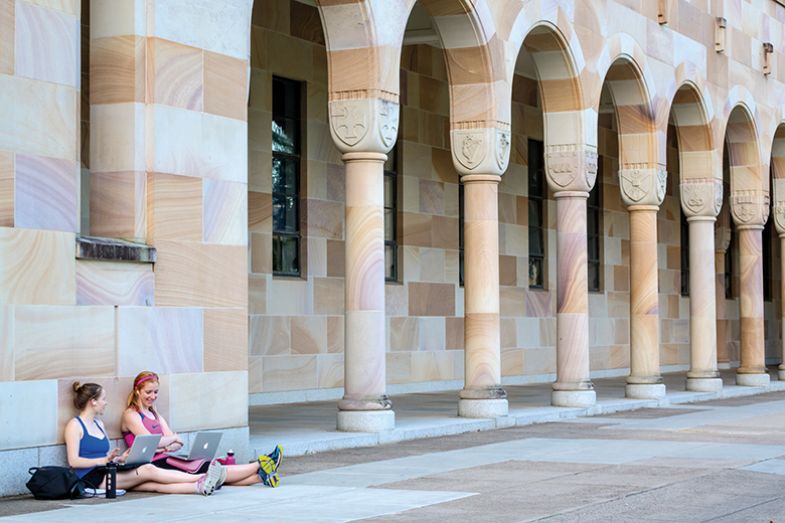Browse the full results of the World University Rankings 2022
Download a copy of the World University Rankings 2022 report
As the world starts to contemplate the promise and potential of the post-pandemic era, many of us (myself included) remain fascinated by the impact of differing national policy responses to fighting the virus and how those policies have played out around the world.
While this has been a difficult time for us all, I acknowledge that many of our friends and partners around the world have endured a much more distressing and tragic experience of the Covid-19 pandemic than we have here in Australia.
Our government’s response to the threat of Covid has involved adopting an “aggressive suppression” strategy. In simple terms, this means acting decisively to prevent community transmission of the virus wherever it occurs.
As I write this in early August, Australia’s various states are again using lockdowns in an attempt to suppress localised outbreaks of the more infectious Delta variant of the virus.
While this strategy has been disruptive for sectors of our society, it has also enabled most parts of Australia to live Covid-free for long stretches of time throughout the pandemic.
Nonetheless, our relative success at quashing the virus, thus far, has come at a cost. It has meant that Australia’s international border has in effect been closed to all non-citizens and non-residents since March 2020 – and it remains closed today.
This has unfortunately prevented international students from travelling to Australia to study at our campuses.
With vaccinations now starting to ramp up here, our government has recently started to chart Australia’s pathway out of the pandemic. Based on this plan, we expect that our international border will gradually start to reopen from early 2022.
By that time, a large proportion of the Australian population should be fully vaccinated – and we should be well placed to safely welcome back international students.
A pause in growth
Before the pandemic, Australian universities had experienced surging demand for education from overseas students.
In fact, the number of international students enrolled at Australian universities increased by a staggering 77 per cent over just five years – growing from about 250,000 students in 2014 to 442,000 by 2019.
These students were attracted by Australia’s reputation as a welcoming and safe multicultural society – as well as by the very high quality of education offered by our universities.
Despite our relatively small population, Australia has six universities among the top 100 in the world, according to Times Higher Education’s World University Rankings.
The US and the UK are the only nations with more universities at the top of the rankings – and, prior to the pandemic, they were also the only two nations with more international students.
Sadly, the flow of international students travelling to study at Australian campuses ceased almost immediately with the closure of our international borders last March.
Their absence is conspicuous, across our universities and Australian society more broadly. We miss the vibrancy they bring to our campuses and the rich cultural diversity they inject into our cities and regions.
Nevertheless, we are continuing to teach the cohort of international students who were already onshore in Australia before the pandemic – as well as tens of thousands of students who are progressing their studies online, from overseas.
Here at the University of Queensland, for instance, about 9,000 of the 55,000 students whom we enrolled in 2020 were studying purely online, from an offshore location.
According to Australian government data, the contraction in total international student enrolments at our universities was surprisingly small in 2020 (down just 5.1 per cent from the 2019 peak). However, the number of international students commencing at an Australian university fell by 23.2 per cent.
That sudden downturn in commencements last year – and again this year – will, of course, flow through to be a more significant fall in total enrolments over the next few years.
While we expect strong demand as soon as international students are permitted to return, it will take several years for the number to climb back to pre-pandemic levels.

A new model of international education
The disruption to Australia’s higher education sector created by Covid-19 (both border closures and the mass adoption of online learning) has been an accelerant of change in our universities.
Most significantly, the pandemic has forced a reconsideration of the most effective model of delivering our programmes to international students in the future. This is a very live strategic debate across our sector right now.
Our government is seeking to develop a new model of international education that is simultaneously more student-centric and more resilient to future shocks.
In March, our federal education minister, Alan Tudge, launched a consultation process with the sector for the development of a new Australian Strategy for International Education 2021-2030.
Ultimately, the government’s intent is to develop a model that encourages more students – from a broader range of nations and dispersed more evenly across the disciplines – to consider the benefits of an Australian university education.
One important consideration is striking the right balance between the offshore, online components of the programmes that we offer and the on-campus, in-person components. In 2019, about 80 per cent of international students at our universities were in Australia for the duration of their degree.
While we are conscious that our prospective international students place a high value on having that cross-cultural, rich on-campus experience, we are also mindful that it comes at a high financial cost when extended over several years. And that cost is prohibitive for students from many nations.
In the future, I expect we will see more of a hybrid model emerge for many Australian university programmes. Increasingly, we will see more international students undertaking an initial period of study in their home country (either online or with a partner institution), before travelling to Australia for a shorter, more intensive, on-campus experience.
Certainly, the Australian government is keen for our universities to find new ways of meeting the educational needs of neighbouring nations in our region.
For example, our northern neighbour, Indonesia, has the ambition to educate an additional 58 million skilled workers by 2030. Similarly, under its ambitious National Education Policy, India wants half of all 18- to 21-year-olds enrolled in university by 2030. To meet that goal, India would need to achieve a doubling of enrolments over the coming decade.
Australia can help fulfil this demand for education by offering greater flexibility in how and when international students learn. And in doing so, we can also make a very positive contribution to the development of nations throughout the Asia-Pacific region.
Australian universities are now assessing their options for future delivery models – ranging from purely online programmes through to hybrid or blended models.
At the same time, there is a renewed interest here in developing deeper transnational education partnerships, including revamped articulation pathways as well as establishing international study centres or full-blown campuses in offshore locations.
Suddenly, all options are on the table.
It proves the maxim that every disruption is accompanied by both challenges and opportunities. Over the past 18 months, Australian universities have been mired in the challenges created by the pandemic, but, before too long, I’m confident that our universities will start to seize the opportunities of the post-pandemic era.
Deborah Terry is president and vice-chancellor of the University of Queensland.
The Times Higher Education World University Rankings 2022 will be published at 00:01 BST on 2 September. The results will be exclusively revealed at the THE World Academic Summit (1-3 September), which will focus on the interrelationship between universities and the places in which they are located.
POSTSCRIPT:
Print headline: Shake it off
Register to continue
Why register?
- Registration is free and only takes a moment
- Once registered, you can read 3 articles a month
- Sign up for our newsletter
Subscribe
Or subscribe for unlimited access to:
- Unlimited access to news, views, insights & reviews
- Digital editions
- Digital access to THE’s university and college rankings analysis
Already registered or a current subscriber? Login








